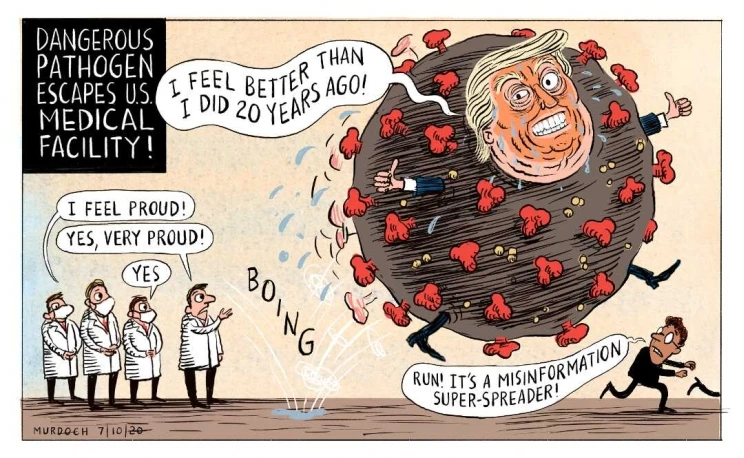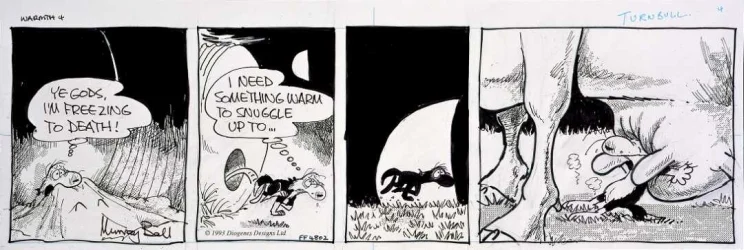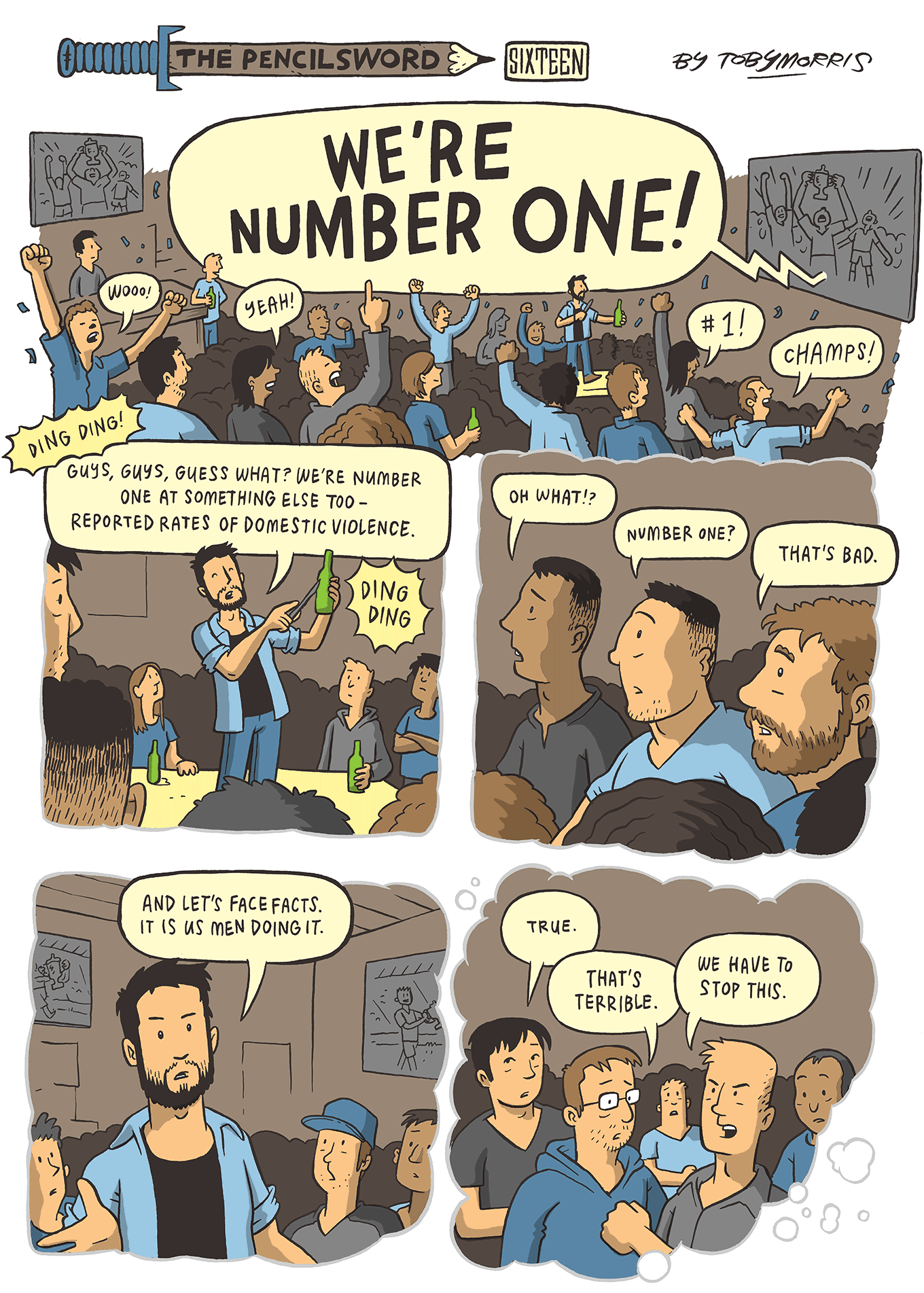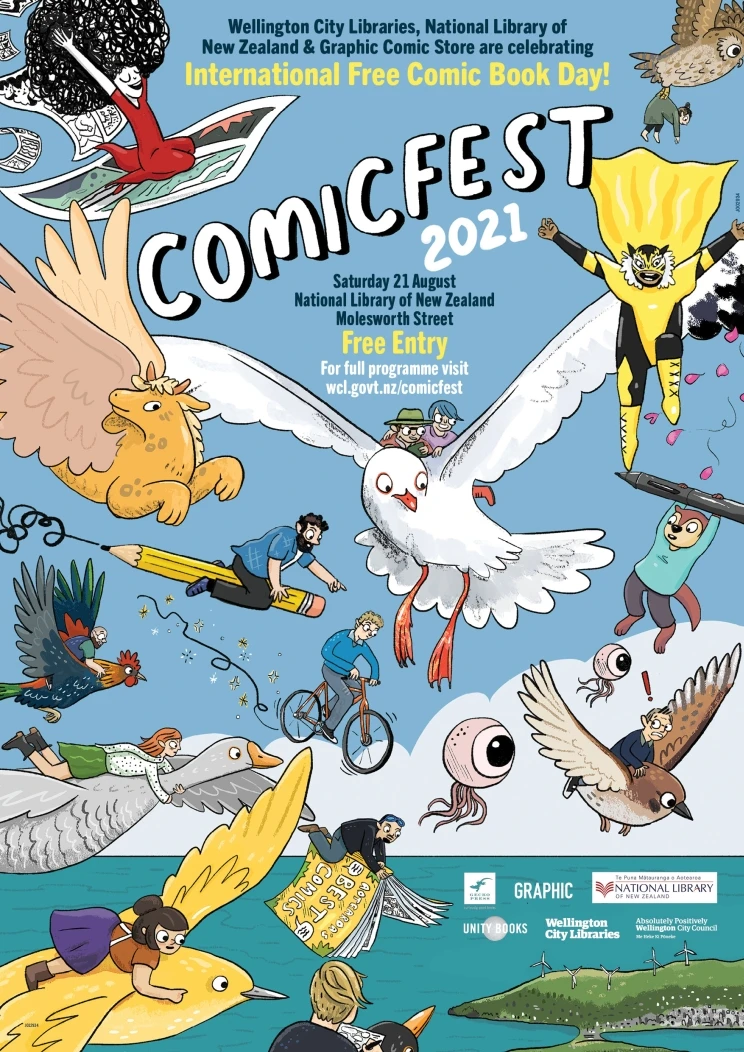What are cartoons and comics?
Sam Orchard, Assistant Curator Cartoons and Comics. talks about comics, what they are, some conventions in comics and the expanding scope of the Library's collecting of cartoons and comics.
The New Zealand Comics and Cartoons Archive
In 2019, the Library reconsidered the scope of the collection and the Archive was formally expanded to create the New Zealand Comics and Cartoons Archive.
Before this, the collection was solely focused on political editorial cartoons. For those that don’t know what this means, they are the comics you see in newspapers — the single panel cartoons that often focus on a political topic of the day. They’re often found in the ‘letters to the editor’ section of the paper.
This is not to be confused with the ‘comic strips’ in newspapers, which are usually found in the section with the word puzzles and crosswords. Those are often multi-panel (hence the name ‘strip’) comics which tell a short, usually funny, story (hence the name ‘comic’).

Sharon Murdoch's Dangerous Pathogen from 7 October 2020. Ref: DCDL-0040328. Alexander Turnbull Library.
Humour not always a requirement
While ‘comics’ were originally named because they were often funny (or supposed to be) the name now extends past that, and humour is not always a requirement for a comic. Comics and cartoons are so much more than those two types found in newspapers — they can include, but are not limited to:
editorial cartoons
comic strips
comic books
graphic novels
sports cartoons
magazine cartoons
manga
comix
comics in zines Webcomics Graphic memoir
That’s a lot of things! But… what exactly is a comic?
We know that it can include all those things above, but what exactly makes a comic… as opposed to a picture book? Or an illustration? Or a game? Or animation? Is it just any combination of words and pictures?
Formalised definitions
Many people have sought to present a formalised definition of comics:
Will Eisner says it’s "the arrangement of pictures or images and words to narrate a story or dramatize an idea", Comics and Sequential Art (1985)
Scott McCloud’s definition is "juxtaposed pictorial and other images in deliberate sequence, intended to convey information and/or to produce an aesthetic response in the viewer", Understanding Comics (1993)
R.C. Harvey, however, says that comics are "pictorial narratives or expositions in which words (often lettered into the picture area within speech balloons) usually contribute to the meaning of the pictures and vice versa", The Art of Funnies: An Aesthetic History (1994)
And all of the above definitions have been critiqued (and sometimes those critiques have been critiqued):
New Zealand’s own Dylan Horrocks examines and critiques Scott McCloud’s definition (Originally printed in “Inventing Comics: Scott McCloud Defines Form in Understanding Comics”, The Comics Journal #234, (2001)
Neil Cohn gives a thorough critique of all three definitions in "Un-Defining ‘Comics’.", International Journal of Comic Art Vol. 7, (2005)
And Aaron Meskin not only critiques these definitions but suggests that we don’t worry about defining comics at all, Defining Comics? (2007)
Sequence and narrative
The major critique is that comics don’t necessarily have to tell a narrative, or be sequential – after all, our very own collection was originally centred around editorial cartoons, which (for the most part) are single panel, and therefore not narrative-driven, or sequential.
Rather than define “comic” Indira Neville has written about the language of comics in What makes a good comic? and things she is drawn (haha) to in comics. She also specifically critiques the idea of “sequence” being integral to comics here: 10 reasons why sequence is not all that — Some opinions about comics.

Murray Ball's 'Ye gods, I'm freezing to death! I need something warm to snuggle up to...' 1993. Ref: A-298-095. Alexander Turnbull Library.
Conventions in comics
If we think about the concept of comics having a language or a series of conventions, that may help us in our journey to discover what comics are, or aren’t:
gutter
panel
caption
speech bubbles/thought bubbles
emanata
sound effects/onomatopoeia
I often think about comics, in the same way, I think about the term ‘queer’ — it’s an umbrella term to cover a range of variants, and (more importantly) it actively resists definition. Comics can be a combination of words and pictures, but not always. Comics can be a series of images in sequence, but not always. Comics can be short funny pieces, but not always. Comics can be pictorial narratives, but not always. They’re often pictures and words, that combined are greater than the sum of their parts — but… not always!
There’s a long history of underground comics, and comix, seeking to push past notions of ‘acceptable art’ through both subject and form. While some people have wanted to legitimise the medium, others haven’t, and sometimes we’ve gotten all mixed up in the process. Indira Neville talks about this in her essay 'Graphic Novels' is not comics. So the idea of having a formalised definition of comics when there’s a segment of comics creators trying to push against and subvert the definition is quite counterintuitive.
So… what’s a cartoon and comics assistant curator to do?
Evolving nature of comics and cartoons in NZ
The expanded scope is intended to be more inclusive, and capture the growing and evolving nature of comics and cartoons in New Zealand, as well as to provide a place for comics that were previously outside the scope.
Having a narrow definition of comics might exclude important works. Past texts and anthologies purporting to highlight New Zealand Comics histories’ use of narrow definitions have resulted in a focus on white cis male creators. This has meant that a lot of our comics histories have not captured the incredible comics by women, queer people, and people of colour.
Having a narrow definition may also not be future-proof as digital and web-based comics evolve the medium further.
For example, comics have been distinct from animations in the past, however, cartoonists, like Toby Morris, animate their comics using gifs.
And Laya Rose features animation, choice and game elements in her comic Overgrown.

Toby Morris, The Pencilsword, #16 — We're Number One, 2017. Ref: DCDL-0036297. Alexander Turnbull Library.
All of the above
So, at this point, the New Zealand comics and cartoons collection regard comics as a fuzzy-edged umbrella term that includes that long list above.
It’s a term that resists definition, it’s a term that covers a variety of techniques and art styles, it is something that is made by a hugely diverse range of creators, and it’s an incredibly exciting place to be working in.
Explore the Cartoon Archive
If you'd like to explore what the Cartoon Archive already has head on over to our collection page and get searching. If you need some help navigating through it, we've put together some handy research guides:
Also, as I mentioned earlier with our change of scope, make sure to check in regularly because we are always adding to the collection.
ComicFest 2021 — Saturday 21 August
Want to learn more? ComicFest 2021 is a great place to come to explore the breadth of comics and cartoons in Aotearoa. The National Library and Wellington City Libraries are excited to host some of Aotearoa’s finest comic artists for a day of workshops, panels and fun. Find out more, and book your tickets here: www.wcl.govt.nz/comicfest.
Thanks to illustrator Giselle Clarkson for creating this year’s poster which features all 14 guests who will appear at ComicFest this year. Giselle is being carried away by the owl in the top right corner, see if you can guess the rest!

ComicFest 2021 poster by illustrator Giselle Clarkson. It features all 14 guests who will appear at ComicFest this year, Giselle is the one being carried away by the owl in the top right corner.